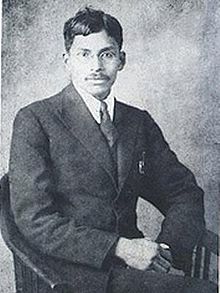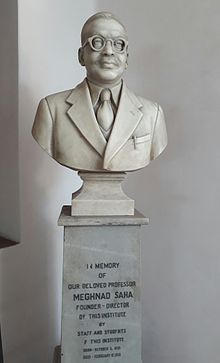Quick Facts
 Libra
Libra
Biography
Meghnad Saha FRS (6 October 1893 – 16 February 1956) was an Indian astrophysicist best known for his development of the Saha ionization equation, used to describe chemical and physical conditions in stars. Saha was the first scientist to relate a star's spectrum to its temperature, developing thermal ionization equations that have been foundational in the fields of astrophysics and astrochemistry. He was repeatedly and unsuccessfully nominated for the Nobel Prize in Physics. Saha was also politically active and was elected in 1952 to India's parliament.
Biography
Meghnad Saha was born in Shaoratoli village near Dhaka, British India (present Bangladesh). Son of Jagannath Saha, Meghnad Saha belonged to a poor family and struggled to rise in life. During his early schooling he was forced to leave Dhaka Collegiate School because he participated in the Swadeshi movement. His Indian School Certificate was earned from Dhaka College. He was also a student at the Presidency College, Kolkata; a professor at Allahabad University from 1923 to 1938, and thereafter a professor and Dean of the Faculty of Science at the University of Calcutta until his death in 1956. He became Fellow of the Royal Society in 1927. He was president of the 21st session of the Indian Science Congress in 1934.
Saha was fortunate to have brilliant teachers and class fellows. In his student days, Jagadish Chandra Bose, Sarada Prasanna Das and Prafulla Chandra Ray were at the pinnacle of their fame. Amongst his class fellows were Satyendra Nath Bose, Jnan Ghosh and J. N. Mukherjee. In later life he was close to Amiya Charan Banerjee, a renowned mathematician at Allahabad University.
On his religious views, Saha was an atheist.
Saha died on 16 February 1956 of a heart attack.
Career


Meghnad Saha's best-known work concerned the thermal ionisation of elements, and it led him to formulate what is known as the Saha equation. This equation is one of the basic tools for interpretation of the spectra of stars in astrophysics, and astrophysicists often use the phrase "to Saha correctly," making Saha one of the few scientists whose name is a verb. By studying the spectra of various stars, one can find their temperature and from that, using Saha's equation, determine the ionisation state of the various elements making up the star. This work was soon extended by Ralph H. Fowler and Edward Arthur Milne. Saha had previously reached the following conclusion on the subject.
- "It will be admitted from what has gone before that the temperature plays the leading role in determining the nature of the stellar spectrum. Too much importance must not be attached to the figures given, for the theory is only a first attempt for quantitatively estimating the physical processes taking place at high temperature. We have practically no laboratory data to guide us, but the stellar spectra may be regarded as unfolding to us, in an unbroken sequence, the physical processes succeeding each other as the temperature is continually varied from 3000° K to 40,000° K."
Saha also invented an instrument to measure the weight and pressure of solar rays and helped to build several scientific institutions, such as the Physics Department in Allahabad University and the Institute of Nuclear Physics in Calcutta. He founded the journal Science and Culture and was the editor until his death. He was the leading spirit in organizing several scientific societies, such as the National Academy of Science (1930), the Indian Physical Society (1934), Indian Institute of Science (1935) and the Indian Association for the Cultivation of Science (1944). A lasting memorial to him is the Saha Institute of Nuclear Physics, founded in 1943 in Kolkata.
Saha was also one of the prominent among the works on Halley's Comet.
Saha was the chief architect of river planning in India and prepared the original plan for the Damodar Valley Project. His own observation with respect to his transition into government projects and political affairs is as follows:
Scientists are often accused of living in the "Ivory Tower" and not troubling their mind with realities and apart from my association with political movements in my juvenile years, I had lived in ivory tower up to 1930. But science and technology are as important for administration now-a-days as law and order. I have gradually glided into politics because I wanted to be of some use to the country in my own humble way.
M.N. Saha and the missed Physics Nobel Prize
The first time, in 1929, Saha was nominated for the Physics Nobel Prize for the year 1930 by D.M. Bose and Sisir Kumar Mitra. The Nobel Committee evaluated Saha's work. It was seen as a useful application, but not a "discovery." Thus he was not awarded the Prize. Saha was nominated again for the Prize in 1937 and 1940 by A.H. Compton; and in 1939, 1951 and 1955 by S.K. Mitra. The Nobel Committee remained to its previous decision.
Tributes to Saha


- "Meghnad Saha’s ionization equation (c. 1920), which opened the door to stellar astrophysics” was one of the top ten achievements of 20th century Indian science [and] could be considered in the Nobel Prize class." - Jayant Narlikar
- "The impetus given to astrophysics by Saha’s work can scarcely be overestimated, as nearly all later progress in this field has been influenced by it and much of the subsequent work has the character of refinements of Saha’s ideas." - S. Rosseland
- "He (Saha) was extremely simple, almost austere, in his habits and personal needs. Outwardly, he sometimes gave an impression of being remote, matter of fact, and even harsh, but once the outer shell was broken, one invariably found in him a person of extreme warmth, deep humanity, sympathy and understanding; and though almost altogether unmindful of his own personal comforts, he was extremely solicitous in the case of others. It was not in his nature to placate others. He was a man of undaunted spirit, resolute determination, untiring energy and dedication." - D. S. Kothari
